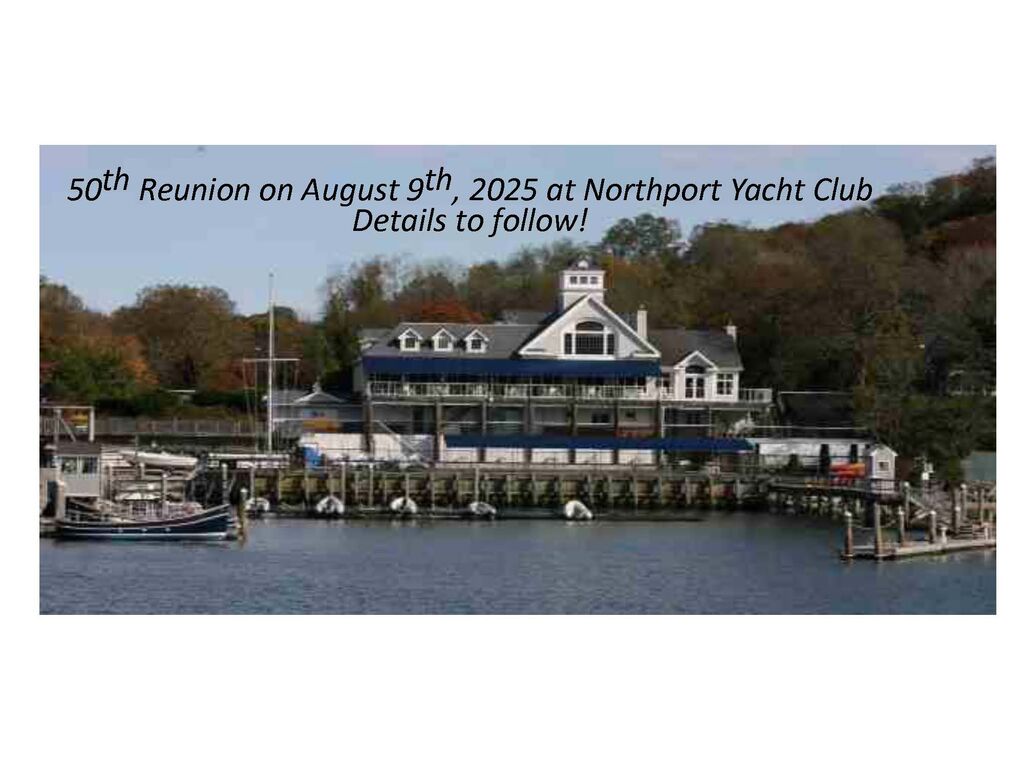 Newsletter for the Alumni and Friends of Hicksville High School - Hicksville, New York
Newsletter for the Alumni and Friends of Hicksville High School - Hicksville, New York
Dear Readers,
We are excited to bring you an article by Ron Wencer about diners in Hicksville! We also feature an article by Wendy Elkis Girnis about Grumman's role in the Lunar Module. There is also a reprint of an Ancient Hixtory Grumman article in this issue. You can log into the site and add your thoughts to articles or email your memories to
- Your HixNews Team
View The HixNews Team
Editors:
- Wendy Elkis Girnis '77
- Stefanie Cedar Shames '77
- Ron Wencer '64
Webmasters:
- Bruce Scherzinger (spouse of Eileen Goldstein '77)
- Gail Schwartzman Mayer '73
- Matt Kennedy '08
- Roger Whitaker (Webmaster Emeritus)
- Karl Schweitzer '81
- John Maniec '64
- Susan Schuler Nolan '77
- Wayne Sternberger '71Editors Emeritus:
- David J. Rubin - '82, Elliot Gorlin - '63
- Valerie Pakaluk - '51, Henry Lichtenstein - '59
- Carol McCormick Konen - '73Founding Editors:
- Pat (Koziuk) Driscoll - '56
- Linda (Piccerelli) Hayden - '60
- Buffalo Bob Casale, '61
 Introduction
Introduction
When the Hixnews team decided to write about “diner memories,” I volunteered to do an Ancient Hixtory article about Hicksville’s early diners. I limited myself to true diners: coffee shops, luncheonettes, ice cream parlors, Howard Johnson’s restaurants, etc. were beyond my scope. My research yield was sparse (evidently, diners were not considered inherently fascinating back then), but I did conclude that the Hub Diner was Hicksville’s first. In addition, my research shone light on a Hicksville-boosting PR campaign of a century ago – a campaign into which the Hub’s name dovetails perfectly.
Background: What's a Diner?
For many, the word “diner” evokes waffles, sticky tables, and a shiny stainless steel exterior. Yet the original diners – called “dining cars” way back when -- were not shiny at all. Converted from obsolete trolleys or railroad cars, and built of wood and ordinary steel, they were thick with paint but thin on glitz. But the public grew fond of them anyway, and manufacturers (especially ones that built streetcars) soon began selling new prefabricated diners, faux versions of the rail vehicles they made.
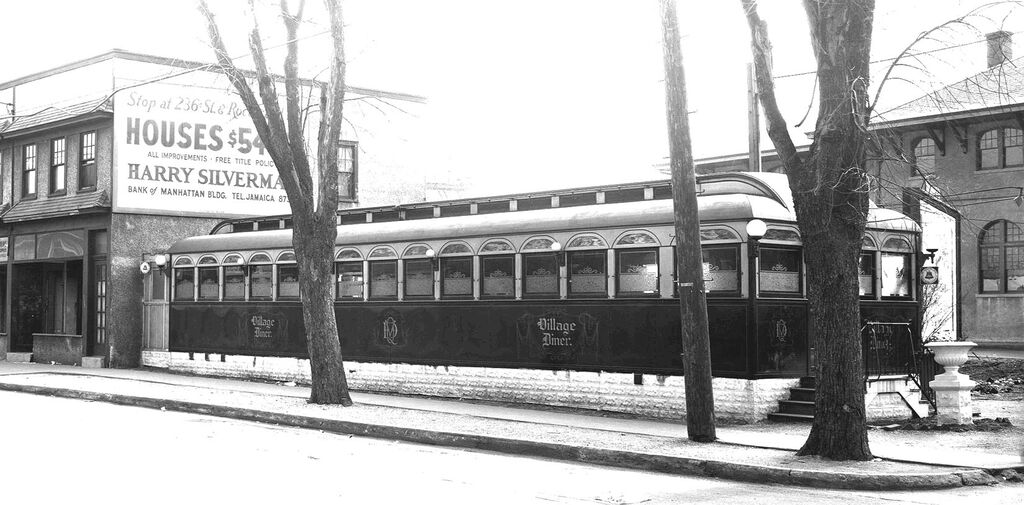 Village Diner, Jamaica, New York, 1930
Village Diner, Jamaica, New York, 1930
Digital Collection of New York City Municipal ArchiveThis is an early pre-fab – the Village Diner on Springfield Blvd. in Jamaica, Queens. It was built by Brill, then the world’s largest manufacturer of streetcars. It may have evoked the aura of railroads, but it was too wide to ever have ridden the rails.
If you wanted to start your own business, it was cheaper to put a diner on an empty lot than to carve restaurant space out of an old building in your town. You laid a concrete block foundation, had your diner delivered, connected it to utilities, and started frying bacon and refilling syrup pitchers. If later you decided that the location wasn’t right for you, you could find another empty lot, hire a mover to transport your diner, and try again.
 1930 Souvenir Postcard of Pioneer Zephyr
1930 Souvenir Postcard of Pioneer Zephyr
Wikipedia.comStainless steel trains and diners were not feasible until engineers devised a process for welding together stainless and structural steel, which happened in the early 1930s. Thus, in 1934 the first stainless steel train entered service, and launched “streamlining” as a new aesthetic. Stainless steel diners followed, and the public loved them, too. Eating in a shiny metal diner let you imagine you were getting a taste (albeit a sticky one) of the future.
Earliest Print References to Hicksville Diners
The Hub Diner was first mentioned in the Long-Islander newspaper in mid-1930, earlier than I have found a reference to any other local diner. Later in the decade, the paper mentions the Fleetwood, which apparently stood somewhere on North Broadway. In addition, there is a mysterious reference to the Hicksville FD’s putting out a small fire at “Ella’s diner.” This might refer to any local eatery, including the Hub – which, I believe, was established in the latter 1920s.
Hubba-Hubba?
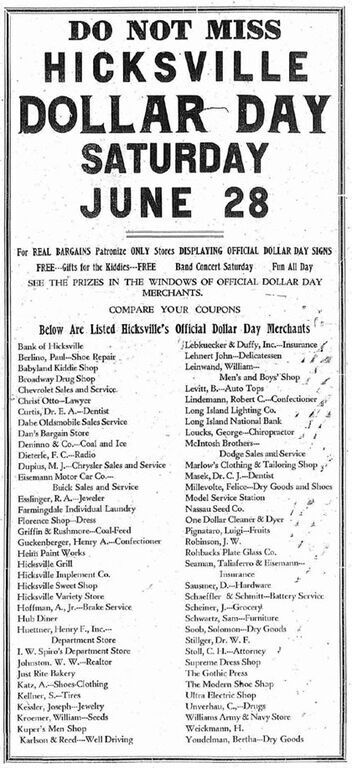 Advertisement for
Advertisement for
Hicksville Dollar Day event
Huntington Long-Islander
June 27, 1930
FultonHistory.comIn 1926, a group of businessmen launched a PR campaign that tried to get people in the region to think of Hicksville as The Hub. This idea must have some about when someone finally understood the blatantly obvious: Hicksville is equidistant from Long Island’s two shores, and what with the roads and the railroad tracks, goods can be shipped between Hicksville and almost anywhere else.
Unfettered, this simplistic vision can skew your thinking until you see Hicksville as the center of the world: everything emanates from, or leads to, Hicksville. It’s the hub around which the business world turns, right? Right? And if you want to persuade others of this, you must decide what Hicksville serves as a hub for. Sadly, when the faithful got the Long-Islander to print a full newspaper column on the topic, the heading was The Hub of the Sunrise Trail. Too bad Mr. Spock was not around to tell the rest of the crew that the slogan was illogical. A wheel has a hub, but the Sunrise Trail – like a snake -- does not. But that’s just my opinion.
There were believers. In 1925 the Hub Service Station opened at the corner of Old Country Road and Broadway. It’s highly likely that in 1928, when the Hicksville Theatre opened, the Hub Diner stood waiting across the street for theatre patrons to also become diner patrons. With Hub mania swirling around downtown, I wonder if anybody considered selling kids’ beanies as Hub Caps....
The ad on the left ran on June 27, 1930. One wonders what kind of “Dollar Day” bargains Elwood Curtis, DDS offered.
Two months later, a classified ad said a “dining car” that was “opposite the theatre” needed an “attractive girl” to be a waitress. “Dining car” suggests this was a faux railroad car pre-fab; “opposite the theatre” suggests it already was where it would remain for decades. Now and then, later references in the newspapers confirm that its address never varied.
We All Age
I have not found any pictures of the Hub Diner as it looked originally. That is not surprising; the complex wooden roofs of early diners were susceptible to leaks. Most owners could not afford to repair an original diner roof. Instead, they built a wooden framework above the leaky roof and then shingled or tar-papered a second roof on top of that (like hanging a tarp over a leaky camping tent). Because the edges of the framework showed above the diner’s exterior walls, they usually were hidden by putting new signs atop the exterior walls.
Note that stainless steel diners could have similar issues thanks to corrosive air pollution and acid rain. If new stainless panels were unaffordable, the walls grew taller (and maybe got stucco applied all over) to conceal the added wood-framing.
The Hub Some of Us Recall
 Michael Dolan's photograph of East Marie Street in 1967
Michael Dolan's photograph of East Marie Street in 1967
“Old Hicksville 1967” (Digital Photograph Album)
Flickr.com
Note: This photo also used for the background of the title block
I was happily surprised to find a picture online that shows the Hub – excerpted below with the diner highlighted – in Michael Dolan’s Flickr album “Old Hicksville 1967.”
At first glance, it looks like an ordinary old building – but now that I’ve looked at scores of photos of rebuilt diners, I see clues that this structure began life as a true diner. The sill height of the row of front windows is unusual for a 1920s commercial building, but it is just right for a diner. Moreover, the facade has no overhanging cornice at the top, an absence that stands out for a 1920s building – but it’s typical for an old diner that has had a new roof added.
More to Come
I hope to do a follow-up diner article, looking at how the early (c. 1958) road widening by NYS affected the two downtown diners that stood just north of the tracks in the early 1950s, one actually in the Triangle, the other facing it from across East John Street.
Speaking of the 1950s... I did learn that in 1951 a liquor license application for the Hub was filed by one Harry Dounelis, who presumably was then its owner.
I am thankful to have access to all of the above, and I am especially grateful to those who maintain the Michael Dolan Flickr albums.
Ciao!
Grumman and the Lunar Module
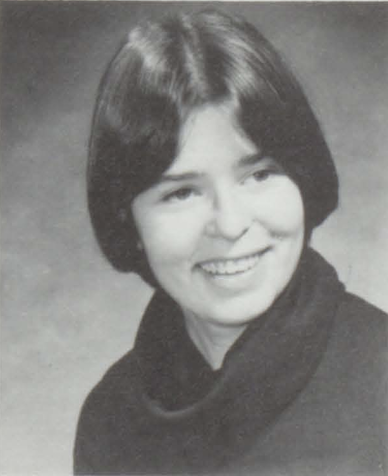 by, Wendy Elkis Girnis, HHS Class of 1977
by, Wendy Elkis Girnis, HHS Class of 1977
If you asked your friends where their fathers worked back in the 1960s, '70s, and '80s, chances are that they would say one of the aerospace companies on Long Island. Companies like Astrosystems, Hazeltine, Gould, Lambda, Harris, Eaton, Fairchild/Republic, and others employed over 100,000 people. Grumman had the largest workforce of all of them.
Grumman's Early Days
Grumman, founded in the 1930s, produced Bi-Planes before WWII. Once the war was over, it began to produce jet fighters. Some of the planes that Grumman built were well known on Long Island. Those were
- Grumman F4F Wildcat
- Grumman TBF Avenger
- Grumman F6F Hellcat
- Grumman A-6 Intruder
- Grumman F-14 Tomcat
A New Frontier
But in the 1960s, Grumman’s focus shifted to the Lunar Module, winning the contract to design and build it in 1962. At least 10,000 people were involved in its production, from engineers to production workers.
Man's First Steps
The Lunar Module, or LM, was designed to carry a crew of two to the moon’s surface. Once on the surface of the moon, the astronauts would use it as a base. When the astronauts were ready to return to the main capsule, the top portion of the LM would serve as transport. My father worked for Astrosystems in New Hyde Park at that time. He was in the Quality Control Department and was responsible for checking the quality of the wire harnesses to make sure they were built to the specifications on the blueprint/installation instructions. On July 20, 1969, we all watched as Apollo 11 took off for the moon. On July 21st, we watched as the Lunar Module named the Eagle, landed on the moon at Tranquility Base. I think everyone in the country Armstrong snaps a picture of Aldrin 1969 celebrated this accomplishment. I remember we banged pots and yelled and shouted with joy. We listened to Neil Armstrong's words as he became the first man to walk on the surface of the moon, followed by Buzz Aldrin 19 minutes later. Then, after spending just over 21 hours on the moon, Armstrong and Aldrin entered the Lunar Module to start the journey home. I think you could have heard a pin drop in our house as we held our breath, waiting for the LM to take off to meet up with the command module. My dad was so nervous. If the engines failed to light, that meant that the wiring harnesses failed, and he would have felt
Armstrong snaps a picture of Aldrin 1969 celebrated this accomplishment. I remember we banged pots and yelled and shouted with joy. We listened to Neil Armstrong's words as he became the first man to walk on the surface of the moon, followed by Buzz Aldrin 19 minutes later. Then, after spending just over 21 hours on the moon, Armstrong and Aldrin entered the Lunar Module to start the journey home. I think you could have heard a pin drop in our house as we held our breath, waiting for the LM to take off to meet up with the command module. My dad was so nervous. If the engines failed to light, that meant that the wiring harnesses failed, and he would have felt  Leaving the moonthat he failed. We watched as the engines lit up, and it finally took off from the moon. I remember hearing my dad start breathing again, and he yelled, "YES!" I am sure that those same emotions went through the 10,000 employees at Grumman who worked on the LM, as well as all of the people who worked on the outsourced materials.
Leaving the moonthat he failed. We watched as the engines lit up, and it finally took off from the moon. I remember hearing my dad start breathing again, and he yelled, "YES!" I am sure that those same emotions went through the 10,000 employees at Grumman who worked on the LM, as well as all of the people who worked on the outsourced materials.
Grumman's Life Raft
During the Apollo 13 mission, though, the Lunar Module was used as a literal life raft. Apollo 13 was launched on April 11, 1970. Two days after its launch, an oxygen tank exploded. That not only caused the mission to be aborted, but it also left the astronauts, Lovell, Swigert, and Haise, in a precarious position. The three astronauts needed to move into the Lunar Module, which was designed to handle two men. It only had enough oxygen for 45 hours but needed to support three men for 90 hours. The astronauts became inventors. They reworked the command modules' lithium hydroxide canisters to work in the LM to clear out the carbon dioxide from the air. Shortly before reaching Earth, the astronauts moved back into the command module and reentered the Earth's atmosphere safely. I remember being a student at Old Country Road Elementary School at the time. A television was set up in the auditorium/gym. We were brought in to watch Apollo 13 reenter the atmosphere and return home. I was so engrossed in watching the television that I never noticed that the students went back to class, and I sat there, eyes glued to the TV, watching and praying they would get home safely, which they did. The astronauts owed their lives to Grumman's Lunar Module.
The first LM was received by the Kennedy Space Center in June of 1967 and launched into space on January 22, 1968. The last of the Lunar Modules never went into space and is on display at the Cradle of Aviation Museum on Long Island.
References:
- Cradle of Aviation Museum - Aviation Heritage of Long Island https://www.cradleofaviation.org/history/history/heritage.html#:~:text=The%20demands%20of%20war%20brought,the%20war%2C%20Grumman%20and%20Republic.
- The American Society of Mechanical Engineers #218 Apollo Lunar Module LM-13 https://www.google.com/search?q=production+lunar+module&oq=production+lunar+module&gs_lcrp=EgZjaHJvbWUyBggAEEUYOTIHCAEQIRigATIHCAIQIRigATIHCAMQIRifBTIHCAQQIRifBTIHCAUQIRifBTIHCAYQIRifBTIHCAcQIRifBTIHCAgQIRifBTIHCAkQIRifBdIBCDYzMDdqMGo3qAIAsAIA&sourceid=chrome&ie=UTF-8
- NASA Space Science Data Coordinated Archive https://nssdc.gsfc.nasa.gov/nmc/spacecraft/display.action?id=1970-029C
- Apollo 11 https://en.m.wikipedia.org/wiki/Apollo_11
Pictures:
- Bi-Plane https://en.wikipedia.org/wiki/Grumman_FF
- Working on the LM https://yesterdaysamerica.com/remembering-the-apollo-program/
- Tomcat- https://aircraft.fandom.com/wiki/Grumman_F-14_Tomcat
- Intruder - https://www.flickr.com/photos/31469080@N07/15888872288
- Avenger - https://en.wikipedia.org/wiki/Grumman_TBF_Avenger
- F6F-https://planehistoria.com/grumman-f6f-hellcat/
- F4F-https://www.thoughtco.com/grumman-f4f-wildcat-2361519
- Avenger https://www.americanairpowermuseum.com/grumman-tbm-3e-avenger/#:~:text=History%3A,bomber%20first%20flown%20in%201941.
- Armstrong pic aldrin https://www.meisterdrucke.uk/fine-art-prints/Neil-Armstrong/1156971/Buzz-Aldrin-with-Apollo-11-Lunar-Module-on-the-Moon,-1969.html
- Leaving Moon https://airandspace.si.edu/stories/editorial/leaving-moon-watching-home
Video of Moon Landing
- Video of astronauts leaving LM https://youtu.be/S9HdPi9Ikhk?si=PAbjMvg_Eel64gOE
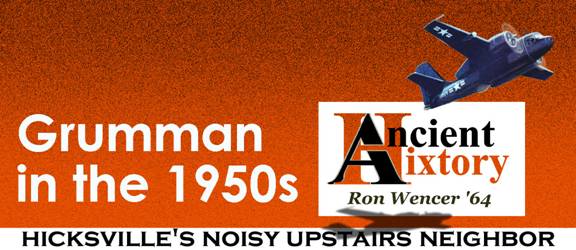
Many of us who grew up in Hicksville during the 1950s got used to hearing loud, sometimes conversation-stopping, airplanes pass overhead. Prior issues of Ancient Hixtory put some of these noisy interruptions into historical context, by discussing the respective roles that Mitchel Field and Republic Aviation played as America in turn faced the demands of World War II, of Korea, of Vietnam, and ultimately, of aerospace.
If you wish, the links below will take you to those articles:
- A history of Mitchel Field appeared here in July 2018.
- The story of Republic Aviation was recounted in October 2018.
This third article offers a glimpse of Grumman Aircraft. That glimpse is of necessity incomplete, for the company's story is extensive, and continues today through Northrop-Grumman. It concerns itself only with the Grumman aircraft I knew best as a child in Hicksville - those which regularly left Bethpage and banked ever so low, over Lee Avenue School, and over my home on 7th Street.
A Too-Brief History of Grumman
Beginnings
Late in 1929, America's aircraft industry was young, improvisational, and - given the recent crash of the stock market - uncertain. Much of the industry was moving to the central Long Island plains, which had not yet erupted into suburbs. Blessed with a "we can do it" attitude, several young men joined together to form a new company, which would be led by Leroy Grumman. As a new aviation company, it needed income to survive "until the business took off" (so to speak). At first, while it pondered how to make its mark, the company sustained itself by doing specialized work for other companies, such as welding aluminum tubing.
Grumman soon found a way to make that mark. In an era in which airplanes could land only on water, or only on land, it built airplane floats with retractable wheeled landing gear. For the first time, an airplane could be based either on land or on water. For that matter, if landing gear that retracted would work for float planes, it would work for land planes, too. Grumman built the first biplane with retractable landing gear. Suddenly, land-based airplanes could fly a little faster (because of reduced drag) and a little further (with less drag, they burned less fuel per mile).
World War II
Grumman's airplanes rapidly began earning the company respect, particularly with regard to the U.S. Navy. Continuing to innovate as the 1930s progressed, the company demonstrated exceptional prowess with fold-and-stow wing designs, and it earned a presence on the flight decks of America's aircraft carriers. Grumman Wildcats, Hellcats, and Avengers would eventually be at the core of America's naval airpower in the Pacific Theatre during World War II.

Deploying folded wings before flight:
a Hellcat aboard USS Yorktown
Wikimedia Commons; Ray Wagner Collection
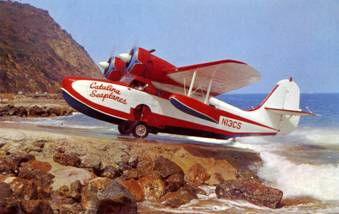
Grumman Goose at Santa Catalina
Tom Wigley photograph
https://www.flickr.com/photos/amphalon/8428551579
The company also penetrated the civilian market, making amphibious aircraft that floated on their hulls. One of these, the Goose, was a dual milestone for Grumman - its first monoplane, and also its first multi-engine aircraft. Built for commuting and small coastal airlines, it also saw service as a light military transport.
Post-War Years
As the Cold War set in, Grumman's markets multiplied:
- It continued to develop and build front-line naval fighting aircraft.
- It developed and built the Navy's first purpose-made anti-submarine aircraft.
- It developed and built the Navy's first early-warning aircraft.
- It developed and built the era's most successful amphibious rescue aircraft.
- It launched the Gulfstream business air transport project.
- It developed and built the Lunar Excursion Module for NASA's Apollo program.
Hicksville's Skies in the 1950s
Around 1950, the bulk of Grumman's manufacturing work migrated to Calverton, which left the runways at the Bethpage headquarters more quiet - but they were not completely silent. In the years that followed, there were numerous flights of private (i.e., business) aircraft, as Grumman executives and engineers met constantly with clients, project partners, and government officials. R&D work on existing aircraft sometimes continued. Now and then, one heard the urgent shriek of a Cougar or Tiger fighter as it climbed out of Bethpage.
During this time, aircraft of two types dominated Grumman's air traffic over Hicksville: anti-submarine and amphibious rescue.
Anti-Submarine Warfare (ASW)
Not Your Mother's Submarine
In World War II, submarines accomplished tactical jobs - attacking military vessels, interfering with supply shipping, surreptitiously transporting agents, even surfacing near shore to strafe targets. By 1950, however, people realized that the next generation of subs would be used more strategically. Someday, a submerged nuclear submarine might remain untraceable for months, and then launch a missile attack on an inland target. This was not some hypothetical notion - the U.S. was about to construct the first nuclear submarine, and within five years, the Soviet Union would effect the first underwater launch of a missile.
Obviously, the ability to detect and disable enemy submarines was becoming critically important.
First Steps
Up to that time, locating and sinking enemy subs was a slow process. It usually involved sending multiple reconnaissance aircraft (often slow, lumbering airplanes that could cover great distances without refueling) on sub-hunting missions. If one of them located a sub, it circled above it, reported its discovery, and tried to mark the spot for the attack aircraft that would be dispatched, usually from a distant location. With luck, the sub would still be nearby when the attack plane(s) arrived.
The Navy now redeployed some of its existing aircraft into dedicated ASW teams. A team consisted of a Hellcat and an Avenger, both of the aircraft having been modified for their new jobs. One served as a "hunter," the other as a "killer". The team approach promised quicker action once a submarine was located.
As the Navy gained experience using teams, it learned a number of things. The most significant was that the amount of 1940s-sized electronics it had crammed into the lean WW II combat planes was insufficient, for they were too small. Larger airplanes, with more room for electronic equipment, were needed.
Guardian
Meanwhile, as demand for specialized ASW aircraft grew, the Navy's requirements for some of its traditional types of aircraft ebbed. Among the several projects it canceled was one for a large carrier-based torpedo bomber. Grumman proposed that the spacious airframe it had been developing for the now-discontinued bomber would work for an anti-sub aircraft, and that by capitalizing on the work already done, development of a "pure" ASW plane would be accelerated. The Navy agreed, and the Guardian program was born. Although Guardian would continue the two-airplane "hunter / killer" approach, the capability of both aspects would be improved substantially.
The first test flights of the resulting aircraft occurred in 1945, but Guardians were not operational until late 1950. Hicksville's quiet potato fields witnessed many low flights of the new planes during these years of development.

Grumman Guardians
"Hunter" (front) and "Killer" (rear)
Flight Journal, flight.journal.com
The bulging aircraft in the foreground above was stuffed with electronic surveillance equipment - and also with some human operators, who coordinated the work of the two airplanes in the team.
Incidentally, the airplane's size may not be apparent from this photograph. When these aircraft were introduced, they represented the largest single-engine airframe ever to have flown from an aircraft carrier.
Tracker
The Guardian was a quickly implemented improvement that adequately housed early stages of electronic surveillance systems. The Navy's experience with it soon led to a more powerful, longer-term solution, one which would give the Navy the all-in-one ASW weapon it desired. The new aircraft was the twin-engined Grumman Tracker.

Grumman two-page advertisement in National Geographic, April 1955
The presence of a prominent advertisement for strategic weaponry in
a magazine like National Geographic was symptomatic of America's
1950s fears. At any time, the Cold War might suddenly turn very hot.
Although the Calverton manufacturing site was operational by now, there still would be continuous work to do at Bethpage while manufacturing proceeded. The need for more R&D into ASW seemed to never stop. In consequence, even as Trackers became operational, one or two always seemed to be around Bethpage (and thus, over Hicksville) to test new ideas. It was hard not to notice Trackers - like many carrier-based aircraft, they were remarkably noisy things, emitting a loud buzz of rapid, crisp, sharp sounds at take-off. Many a window on 7th Street rattled when they flew overhead.
Eventually, Trackers would be used by a wide range of friendly forces, including those of Australia, Turkey, the Netherlands, and Argentina. One of the early foreign adopters was Japan, which under the terms of the 1945 peace treaty had been limited with respect to possessing military aircraft for its own purposes. In 1957, it acquired several Trackers, which were categorized as defensive aircraft.
I can remember the day when I first became aware of that. My class at Lee Avenue was out in the large grassy yard behind the school, and not for the first time, things suddenly got loud. The school was directly in the path of traffic from the main Grumman runway, and brief but intense aircraft noise was common (e.g., if classroom windows were open, a teacher sometimes had to stop speaking until a plane was gone). This time, the noise was louder than usual. When I looked up, I saw two Trackers approaching in tight formation, one diagonally behind the other; they must have taken off simultaneously. What struck me instantly was neither the racket nor the tight proximity of the aircraft, but their markings - they bore the large red disks that signified Japan.

In Japanese service, the Tracker was called "Aotaka," which means
"Blue Hawk." Its time in the Japan Air Self-Defense Force complete,
this unit is now displayed at Kanoya Air Base Museum.
Wikimedia Commons, photographed/contributed by Hunini
Momentarily, that insignia gave me pause. My father, like the fathers of many of my fellow students, often watched Victory at Sea and other post-war documentary television programs, and I usually watched with him. To now see Japanese aircraft approaching low over the schoolyard briefly brought to mind black-and-white scenes of wartime attacks.
A quick look around showed me that no one else in the schoolyard had looked up at the Trackers. I watched them fly overhead harmlessly, shrugged, and went back to whatever I'd been doing, but I never forgot that moment.
***
It a Pelican?
From the 1930s, one of Grumman's traditional niches had been building amphibious airplanes, which inevitably were named after water fowl. Over the years, the amphibians had grown in size, from the single-engined Duck to the twin-engined Goose, through the larger Widgeon, and then to the still larger post-war Mallard. The latter was something of a transitional aircraft - it had a strong appeal for corporate and wealthy individual clients (e.g., the Aga Khan bought one), but it did not penetrate the regional airline market as deeply as Grumman had hoped.
Grumman proved nimble. It quickly decided to extrapolate the Mallard's design into a larger, higher capacity, longer-range version, initially designated the Pelican, which made its first test flight late in 1947:

First Pelican test flight, October 24, 1947
thisdayinaviation.com/tag/grumman-sa-16-albatross/
Ironically, enlarging the design did not help it penetrate the coastal airline market - in the late 1940s, there were too many cheap war-surplus transports available, and too many small airfields they could use. Besides, other than at an amusement park, would you want to ride in something called the Pelican?
On the other hand, the new aircraft was remarkably well suited for rescue missions.
No, It's an Albatross
"At length did cross an Albatross,
Thorough the fog it came;
As if it had been a Christian soul,
We hailed it in God's name."
Samuel Taylor Coleridge
The Rime of the Ancient Mariner
The traditional superstition that albatrosses aided mariners in need led to Grumman's renaming the new aircraft. The name Albatross stuck, for the aircraft was perfect for rescuing the survivors of disasters at sea, as well as for providing relief to the populace of storm-damaged islands. Introduced to U.S. forces in 1949, it also was used by many foreign air services, in some of which it served well into the 1990s.

Per this advertisement, in 1955 the U.S. Air Force's
Rescue Squadrons around the world flew more than
3,000 missions, averaging about eight hours each, to
save nearly 2,000 people from death, and to deliver
relief supplies and medical aid to more than 20,000
disaster victims.
National Geographic, May 1956
Like other Grumman planes, the Albatross was improved as the years went by, which resulted in continued test flights out of Bethpage. The most significant change was the development of a longer-range version, with a 20% greater wingspan. In order to maintain good flying characteristics, the tail-end control surfaces were correspondingly enlarged as well.
Late in their USAF service, some Albatrosses were refitted for special missions in Vietnam.

Non-Grumman Albatross
Caleb Slemmons photograph
Allaboutbirds.org
***
Beyond Anti-Submarine Warfare
Within three years of the Tracker's becoming operational in 1952, Grumman delivered (at the Navy's request) a transport version of the Tracker, called the Trader. Although the versions looked alike at first glance, the new aircraft had a broader body, and its greater interior space made it better suited for transporting personnel or cargo.

not a Tracker, but a Trader
National Archives and Records Administration

Grumman Tracer
U.S. Navy National Museum of Naval Aviation
Grumman was very busy indeed; another spin-off followed a year later. The larger airframe designed for the Trader also became the basis of an early-warning aircraft, the Tracer. For obvious reasons, the appearance of the Tracer was distinctive. As I recall, when one of them flew over Hicksville in those years, it usually was accompanied at takeoff by a Trader - unless it was it a Tracker - the crew of which monitored the domed aircraft, likely watching for aerodynamic problems or other flight issues.
The radar dome was, of course, something new for Grumman, and it had an impact on Grumman tradition: it forced the company to revisit its venerable Stow-Wing hinge design. To avoid hitting the dome, the Tracer's wings had to fold backward, rather than upward as usual.
The Tracer served in Vietnam, providing attack vectors for U.S. aircraft, and also alerting U.S. forces to enemy interceptor activity. It was finally withdrawn from service in 1977.
***
Leaving the 1950s Behind
As the 1960s loomed, two new projects were getting under way. Neither would get off to a promising start.
One was the Mohawk, an aircraft originally proposed in response to similar requests made by the Army and the Marine Corps, both of which wanted multi-purpose all-weather aircraft that could operate from small unimproved fields. As the project tried to progress, it was impeded (and almost scuttled) by decisions reached by the Navy and the Air Force - neither of which had been directly involved when things started.
When the dust settled, it was determined that the Mohawk was to be built only for the Army. It served well in a variety of roles in Vietnam, and also in Desert Storm. After more than three decades of service, it was retired in 1996.

U.S. Army Mohawk
Max Haynes photograph
MaxAir2Air.com

E2A Hawkeye
Wikipedia Commons
The other project was the E2A Hawkeye, a carrier-borne early warning Aircraft meant to replace the Tracer. The project's early years struggled with two significant issues: size and heat.
The Hawkeye was to be a state-of-the-art aircraft that could be at home on Essex-class (i.e., World War II design) aircraft carriers. Although not excessively old, these ships were small for carriers, even by the standards of the day. They had been upgraded, so that they could accommodate early jet aircraft. The Navy - which was already building larger new carriers - was not going to rebuild them again. Having to make the Hawkeye small enough to fit on the old carriers meant that the mandated equipment inside the airplane got crammed together, making the crew's work very difficult.
Things were made worse by the computers with which the Hawkeyes were first equipped. Beginning in the late 1940s, the Navy had participated with private industry in the development of "drum computers." Unlike today's computers, which use memory chips for RAM, these computers used rotating metal drums (i.e., cylinders, similar in concept to those used for early phonographs, but which retained magnetic charges). The computers generated a great deal of heat, and in flight they often failed, due either to the heat itself, or perhaps to the effect upon drum rotation of the inevitable sudden movements of the aircraft.
These conditions rendered the E2A unreliable at best. Ultimately, they were addressed by withdrawing it from service, and rebuilding each E2A into an E2B. Among the many improvements introduced was replacing the drum computers with more modern machines, likely ones which instead used more reliable magnetic core memory, which had been gaining widespread acceptance for several years. Unlike its predecessor, the E2B worked quite well.
*
At the time that the E2Bs were introduced, two aircraft were set aside for ongoing use as test beds for the evaluation of future radar technology, which was advancing quickly. Such tests kept them flying over Hicksville for a long time. This research effort led to the substantially more capable E2C Hawkeye of the 1970s, which could interact smoothly during missions with the computers aboard friendly combat aircraft (e.g., Tomcats). The research did not stop there; more recently it has produced the E2D, which today plays a key Navy role as an Airborne Warning and Control System (AWACS) aircraft.
I find it incredible that the Hawkeye, an aircraft which Grumman began designing in the late 1950s, has been improved continuously for 60+ years, so that now, well into the twenty-first century, it is still a crucial part of America's combat forces. Leroy Grumman would feel proud.
*****
Coda
This month, the sources named in the captions are all that I shall list specifically. Over the years, I have read many other relevant books and articles - too many to mention or remember - especially during the latter 1970s, when we lived in Bethpage, adjacent to the head of the Grumman runway that was used early every morning by Hawkeyes. For those who are interested in reading more about Grumman, there is ample material available online, in libraries, and in larger bookstores.
*
As with people who serve in uniform, after retirement from the military, a number of Trackers and Traders continued to serve in other ways. Many of them began new careers as water bombers in Europe and in the Americas. Although they could at best carry "only" about 1,200 gallons at a time, the Grummans were agile fliers, and with good piloting they were able to drop their loads more precisely than could many larger aircraft./p>
I leave you with this recent picture of a Grumman Tracker in France, one of the few Tracker water bomber conversions still flying.

Turbo Firecat of the Sécurité Civile, the civil defense arm
of the French Ministry of the Interior
This aircraft is one of 35 water bombers built in the 1980s by
Conair Aviation from former Canadian and American Navy
Trackers, many of them upgraded with more modern engines.
The Turbo Firecats of the Sécurité Civile are expected to keep
fighting fires in France until they are retired in 2022.
skiesmag.com
Anthony Pecchi photograph
*****
Ciao!
Etcetera for August 2024
Peppercorns in Hicksville
Peppercorns in Hicksville is officially closed. Julie Ugarte, a resident, created a petition on Change.org to save the building from destruction. This is the update from Julie Ugarte: We currently have 2,416 signatures, and the Department of Planning and Development has said upon receiving the application that there has been a hold put on 25E Marie Street until a decision about landmark status is finalized. No demolition or exterior change can be made until then.
In Memoriam
*We recently learned James A. Swiatek (Class of 1968) passed away on June 4, 2008 from bile duct cancer. His brother, Glenn M. Swiatek, Esq. wrote to HixNews: I talked to Bob Casale about this a few years ago, but it never happened. I know he had other things going on. Bob lived across the street from us on Edgewood Drive. He actually used to babysit me when I was a little tyke. Very few people outside of our family know of his passing. I would like to hear from some of his classmates. My email address is
*We also recently learned Karen Feinberg Mahon (Class of 1970) passed away from cancer on July 30, 2022. (Submitted by her sister, Laura Feinberg Scholtka (Class of 1972)).
*While searching for obituaries, we learned of the passing of Joanne Irene Kleiner (Class of 1970) on June 1, 2021.
*Thank you to Thomas Murphy for submitting the obituary of John M. Lepper (Class of 1968) on December 26, 2023.
*Bob Fulgham let us know about the passing of his good friend, James P. Dugan (Jimmy D), Class of 1973) on June 1, 2024. Bob reports, "He was a good guy who always had a smile on his face. When I got out of the Air Force, Jimmy and Tim Reddy flew out to California, and we spent two weeks meandering across the country back to NY. It was one of the best times of my life, filled with great memories. Jimmy lived in Hicksville his entire life. Rest well, my friend."
*Thank you to Karen Jenkins (Class of 1962) for letting us know about the passing of John H. Marcel (Class of 1975) on August 2, 2024.
*It is with great sadness that I must report that my lifelong buddy and dear friend, Len Cuccaro, Class of 1957, passed away on July 28, 2024. He was a retiree from Grumman and living in Roanoke, VA. His obit can be seen at Leonard Cuccaro Obituary (2024) - Legacy Remembers .
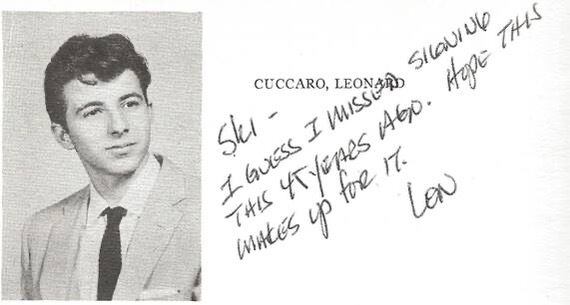 Thanks,
Thanks,
Pete Foster 1957
*Faye Mentnech Turchiano (Class of 1969) passed away, according to a post on Facebook by her sister, Dale Mentnech Baker.

This is a separate reunion from the multi-class reunion that is planned.
This is a "Save the Date" for the Class of 1975's 50th Reunion next year. We have an active, private Facebook group at https://www.facebook.com/groups/67266179651 (Hicksville High School Alumni Class of 1975) that will have the most current information. The group needs approval to join and is currently at nearly 500 members.
A message from Diane Allen Romano, as appeared in the Hicksville High School Alumni group on Facebook on August 18, 2024:
Multi-Year Reunion Open for All Years
Hello to all Hicksville High School Graduates- We are about 2 months away from our planned multi-year reunion. We are starting to get checks in, and I will be posting almost every night because I get dozens of messages each day. We expect over 300 people (we had over 400 last time)- so please commit as early as you can.
The date is September 27, 2024. All are welcome. It will be from 8 pm to 12 am at the Milleridge Inn, 585 N. Broadway, in Jericho. They did such a great job with the last one. There will be a DJ, a photo booth, a full buffet, and top-shelf liquor.
Please share this note on any platform you think appropriate, forward it to your friends, and private message me with any questions.
The price per person is $155.00.
Please send checks to 17B East Old Country Road, Hicksville, NY 11801, PO box 222. Please make the checks out to Nancy Rooney. Or you can Venmo me, Diane Romano.
The Venmo for me is @diane-romano-1
Attendees are added below:
1971- Bobby Bloom, Joe Gervasi, Carol Greenstein Epstein, Richie Hoffman, Sallye Globerman Pecker
1972- Pete Gaffney, Dennis Hanifan, Joanne Phelan, Bob Starke, Phil Urena
1973- Louis Bell, Claudia Dergin, Ricky Doolittle, Brad Ernst, Kathleen Farina, Marylou Hanifan, Pete Humann, Gene Lederer, Linda Schairer Maksym, Wayne Miranda, Robert Owen, Kathy Price Klutch, Diane Allen Romano, Rona Schneider, Linda Ruggiero, Diane Szerba, Kim Torrellas, Joe Varecha, Barbara Zahn
1974- Emmett Allen, Ross Burwasser, Tom Connelly, Jimmy D'Antuono, Jimmy DeNicola, Frank Gervasi, Tom Gill, Robert Gucker, Greg Hudson, Kevin Induddi, John Liberatos, Glenn Murphy, Marybeth Murphy Krumenacker, Brian Lofthus, Michael McCarthy, Mary Bauer Mims, Tom O'Neill, Glenn Pfaeffle, Chris Roach, Nancy Rooney, Ray Schoenig, Mike Shalley, Mary Tufts, Bill Wayte, Jimmy Wittenburg
1975- Debbie Bloom Burwasser, Barbara Bauer Lofthus, Kevin O'Brien, John Polli, Ken Ponsiek, Sue Wayte, Lynn Carbonella Zybol
1976- Henry Charles, Gerri Denien, Tommy Denien, John Farina, Mary O'Toole Hudson, Joanie Longo
1977- Donna Heeter, Janice Messina, Kathy Allen O'Brien, Joe Longo, Walter Relling
1978- Anthony Allen, Michael Harwood, Denise Oliva, Gloria Stasi Warren
1980- Carolyn Messina
1981- Toni Ann Camara Kaste, Mark Murray
1982- Maureen Roach

